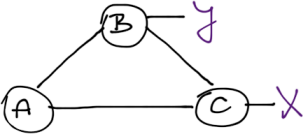Loop-Free Alternate: OSPF Meets EIGRP
Assume we have a simple triangular network:

Now imagine the A-to-C link fails. How will OSPF react to the link failure as compared to EIGRP? Which one will converge faster? Try to answer the questions before pressing the Read more link ;)
EIGRP: Feasible Successors
EIGRP tries to use feasible successors to speed up the convergence process. Whenever B reports its distance to X to A, A compares B’s reported distance to its current feasibility distance. Lower reported distance means that B doesn’t use A to get to X (A is not B's successor). B is also not A's successor for X (that’s C as long as the A-to-C link is operational), but it’s a feasible successor. Using B to get traffic to X will not result in a routing loop.
A feasible successor is evaluated for individual destinations. From A’s perspective, B is a feasible successor for X and C is a feasible successor for Y.
Faced with A-to-C link loss, A can switch immediately to the feasible successor (B) for destination X. Convergence is immediate.

EIGRP convergence after a link failure
OSPF: Let’s Make Sure We’re in Sync
OSPF is way more lackadaisical:
- It changes the LSAs affected by the updates and floods them unless there’s been a recent topology change, in which case it goes and sits quietly in a corner until the timers throttle lsa hold-interval expires.
- It waits a bit more, silently lamenting its misery, until the timers throttle spf spf-start timer expires.
- It runs SPF algorithm, computes the new OSPF shortest-path tree, and copies the results in the IP routing table.
Total convergence time: 5+ seconds (unless you’ve done some serious tweaking).
Loop-Free Alternate: Feasible Successor for OSPF
There’s no reason OSPF couldn’t have reacted faster – every single router knows the whole topology of all attached areas and can thus easily calculate which of its neighbors could be feasible successors. That’s exactly what LFA is doing:
- OSPF (or IS-IS) routing process runs SPF, computes its own best paths, and installs them in the IP routing table (RIB).
- After the network has converged, OSPF runs SPF algorithm from the perspective of its neighbors. If a neighbor’s SPF tree doesn’t use current router as the next hop for a specific destination, it’s safe to use that neighbor as a feasible successor.
- The feasible successor information calculated by OSPF is downloaded in RIB and FIB, where it can be used immediately after the link failure.
Can I use it?
Loop Free Alternate Fast Reroute is available in Cisco IOS (OSPF, IS-IS), Junos (OSPF, IS-IS), IOS XR (OSPF, IS-IS) and other network operating systems.
More information
- Fast Failover section in How Networks Really Work webinar
- Basic Specification for IP Fast Reroute: Loop-Free Alternates (RFC 5286)
- Understanding and Deploying Loop-Free Alternate Feature (Junos Implementation Guide)
- Nice introductory article by Tony Brown
- IP Fast Reroute Applicability – EuroNOG presentation by Pierre Francois (with lots and lots of details and topology analysis).

http://www.cisco.com/en/US/docs/ios_xr_sw/iosxr_r3.5/routing/configuration/guide/rc35rib.html#wp1088695
Enterprises will most likely not implement MPLS en masse anytime soon, as the majority of installed and currently orderable enterprise gear doesn't support MPLS at all.
1. On the CPU based platforms there should be no difference between EIGRP and IP LFA.
2. On the distributed platforms IP LFA will be faster as HW FIB is ready for a switchover.
In terms of your recursive process maybe you started at the intra-AS BGP convergence topic or possibility of the fast path switchover when you were in the serious traffic jam?
sheeshe it is 2012 where is that one protocol for all.
Okay where is the post for IPX/SPX where you can have a 10k node network and none of the subnetting issues etc and now since we can all have 1 to 10gig links who cares if it is a heavy protocol. ;)
#3 - Good thinking, but I started somewhere far far away 8-)
But my comment was for IPLFA vs. EIGRP. :)
In practice when testing I see much quicker failover than OSPF dead time expiry. I reckon the link failure is detected in hardware, RIB, FIB entries are removed and this potentially forces OSPF to recalculate a path?
In other vendors, Juniper and other support MPLS as well. I think the adoption doesn't have to do with gear as much as it does with education.
-> a set of paths which will get a PDU closer to its destination than the local system: these are called downstream paths
The basic idea is as long as the cost from the neighbor is less than the cost from me, I can forward the packet for a particular destination to it.